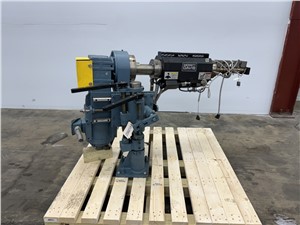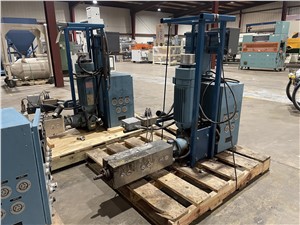Arlington Machinery Makes Buying Extruders Easy.
When an in-person inspection is difficult or not an option, if we have the machine in stock here are some of the services we can provide.
Barrel and Screw
- Clean and measure barrels up to 8”.
- Measure screw flights and generate a report of condition and screw style
Main Extruder Motor
- Test run WITH VIDEO
- Inspect electrical connections for damage
- Megger test
- Resistance test
- Inspect mechanically including bearings and motor cooling
- Control Panel
- Operate temperature controllers to verify proper function
- Test rpm readout and potentiometer and verify accuracy
- Test and verify E stops function
Barrel Heating
- Operate temperature controllers to verify heater amperage
- Check thermocouple and terminal connections
- Test and verify blowers function.
Water Cooling
- Check pumps and plumbing for leaks
- Verify solenoids function with controllers
- Pressure test heat exchanger
Gearbox
- Check oil and lube systems for functionality
- Inspect oil for metals or sludge
- Visually and with cameras, inspect gears for wear and damage
- Check for noises and vibrations at normal extruder speeds.
Typical Single Screw Extruder Specifications and What they Mean
Screw Size – The Screw is the heart of the extruder. It is measured in outside diameter most extruders are between .75”-10”. The most popular sizes are 1.5”, 2.5”, 3.5” 4.5 and 6”. The effective length of the extruders typically 24-36 L/D although can be shorter or longer for specialized applications. The L/D of a single screw extruder is the ratio of the length over the diameter.
Motor and Gearbox – Extruders are variable speed with either an AC motor or DC motor. DC motors have been the longstanding standard for years, however AC motors are becoming more and more popular with plastic processing. These motors can be direct driven or belt driven to gear reducers. It is important to be aware of the gearbox reduction on the single screw extruders to maintain proper screw output speeds for your material.
Barrel Cooling – Extruders will can be equipped with Air cooling or water cooling. Air cooling which is done with fans in in general less difficult to use. Water cooling is a more effective then air cooling, however tends to require more maintenance and in general more difficult to maintain.
- Extruder instruments and controls
- Temperature Control for barrel zones-outputs for heat and cool with temperature display
- Temperature Control for die and downstream zones-heat output and temperature display
- Rpm Gauge is for the speed of the screw
- Amp Gauge- is the amp draw for the main motor
- Melt temp gauge- is a reading of temperature at the die
- Pressure is the die head pressure
Other Important Information to Consider
Centerline Height – The height of the center of the screw to the floor. Typical height is 42.5”. Higher could be called Highboy Extruder, lower would be called Low Boy Extruder
Feed Throat Size and Geometry – The opening and shape of the feed section of an extruder should be chosen with the material and bulk density in mind.
Screw Design – There are many different variations of extruder screws. Conventional single stage screws have a constant pitch. Two stage screws are used for venting. Screws also can have various forms of mixing for specific applications.
Above is a very brief description of the components of a single screw extruder. Please feel free to contact and Arlington Machinery salesman to help find a used extruder that will fit your application.

.JPG)
.JPG)

.JPG)
.JPG)
.JPG)

.JPG)
.jpg)
.jpg)
.JPG)

.JPG)
.JPEG)
.JPEG)
.JPG)